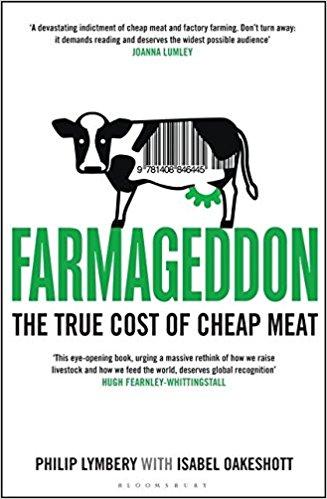Farmageddon Summary
<1 min read ⌚
 The True Cost of Cheap Meat
The True Cost of Cheap Meat
Meat is supposed to be good for you, right? That is what your grandparents taught you. Anend look how long and healthy lives they had.
Well, those days are long gone. If you are buying your meat at the local supermarket, it probably does you more harm than good.
This summary of “Farmageddon” will make you think twice whether you should eat that piece of meat the next time someone puts it on your plate.
Who Should Read “Farmageddon”? and Why?
“Farmageddon,” tells you everything there is to know about present-day farming and all of its problems and examines the pros and cons of different agricultural options.
It covers topics such as environmental pollution, human misery, and animal cruelty, and gives some pretty ugly outcomes if we do not embrace change soon. On the bright side, it lists some practical solutions, and fuels hope.
We recommend “Farmageddon” to environmentalists, futurists and all people deciding what to put on their table.
About Philip Lymbery and Isabel Oakeshott
 Philip Lymbery is an activist for human health and animal safety.
Philip Lymbery is an activist for human health and animal safety.
Isabel Oakeshott is a commentator and a political journalist.
 They wrote “Farmageddon” to raise the awareness for the issues that mega-farming creates in the world.
They wrote “Farmageddon” to raise the awareness for the issues that mega-farming creates in the world.
“Farmageddon Summary”
First, let’s talk about the cycle of nature, or the food chain.
Back in biology classes, we learned that nature produces foods, some of which people do not eat, but animals do.
Then, animals convert this food into waste, which is a natural fertilizer for the forests, fields, and oceans.
Then, humans get in the picture. They butcher the animals and eat their meat. And so the cycle continues.
This is the natural food chain.
However, things have changed since the times we took biology. In the modern world, things are done differently.
With the increasing global need for food, people started opening commercial farms.
In commercial farms, animals lack normal conditions of life. They are put in small spaces, fed grains, and other food to make them fat faster, and give them tons of antibiotics. All of this results in cheap meat produced in ways that are far from environment-friendly.
Nowadays, everything seems to be “mega.”
Let’s start with megafarms.
People built the first megafarms in deserts, that they watered by taking water from faraway rivers. Then, they soak the soil in chemicals that allow them to produce vegetables, fruit, meat, and flowers.
Next come the mega-dairies, which are “home” to nearly two million cows.
We already talked about the adverse conditions these animals are kept in, which, by the way, shorten their lives by a decade, but you know what increases the problem even more?
These cows produce a massive amount of waste, which then pollutes the local water supply.
The animals are not the only ones that suffer. Farmers have a hard time too, overworking themselves while trying to meet the increasing demand and pressure for produce and make a living.
Over-consumption has a harmful effect on the environment. Farmers have to plant genetically modified soy, corn, wheat and other grains so that they can feed the animals. Sure, at first they do reap bounties, but soon the land needs more chemicals to keep being fertile.
However, that cannot last forever. Chemicals soon poison the land so much, that nothing can grow.
However, this food is unhealthy and shortens the lifespan of many people around the world. Have you noticed that people are getting sick and dying young every day, despite all medical advancements?
It has to do something with our way of life, don’t you think so?
Studies show that the nutritional value of the factory meat is nothing compared to that of organically produced meat. Factory meat is full of unhealthy substances, chemical and additive residue and fat. The “good to bad” fat ratio of farmed meat is 1:50, as opposed to 1:3 in the wild animals.
It is no wonder that every day more and more people turn against these wrong ways of producing food. Being green and caring about the environment is a notion that almost everyone slowly starts to adopt.
Going back to traditional farming and fishing is the only path toward a healthy, safe and sustainable future.
Key Lessons from “Farmageddon”
1. Chicken and Egg
2. Fish Farming
3. Global Pandemics and Health Problems
Chicken and the Egg
The chicken business is the “talk of the town,” so to speak. Hens live (and die) in tiny cages, which allow them only to sit still.
Farmers feed them antibiotics and additives, which make them lay more eggs, and grow and become fatter faster.
Such treatment is cruel for the birds and bad for the people – since it results in bad meat and environmental waste.
Fish Farming
The aquaculture faces the same problem, just as everything else.
Businesses capture wild fish to feed captive fish – and sell it to people. So, seabirds are left without food, and local fishers without work, as small wild fish population declines.
Fish farming creates an imbalance in the natural system and uses perfectly healthy and sustainable fish to feed sickly, farmed fish. It furthermore pollutes the waters all around the world, destroys jobs and tourism.
Global Pandemics and Health Problems
Maga-piggeries use massive amounts of fuel and water and as a result, produce unsatisfactory and unhealthy product.
But that is not the biggest problem.
Evidence suggests that piggeries breed diseases that could harm humans everywhere. If you do not believe us, just think of the Bird Flu, and remember the many lives it took.
Like this summary? We’d Like to invite you to download our free 12 min app, for more amazing summaries and audiobooks.
“Farmageddon” Quotes
The harder farmers push animals beyond their natural limit, and the more closely animals are confined, often the greater the risk of disease and the heavier the reliance on vets to keep herds alive. Share on X It is difficult to persuade vets who have invested so much of their careers in propping up intensive farming to turn their back on such systems. You’re asking the high priests of the livestock ministry to reject everything they know. As… Share on X Once a virus gets into an intensive poultry shed it can move quickly through the flock, constantly replicating itself. Share on X Make no mistake, rearing animals is a thirsty business. Worldwide, around a quarter of freshwater use relates to producing meat and dairy. Share on X On average meat needs around ten times the amount of water per calorie to produce as vegetables and other plants. Share on XOur Critical Review
“Farmageddon” thoroughly examines the pressing problems of modern farming and agriculture. One thing is certain: after reading this book, you will never look at a piece of meat in the same way.
Emir is the Head of Marketing at 12min. In his spare time, he loves to meditate and play soccer.


 The True Cost of Cheap Meat
The True Cost of Cheap Meat




